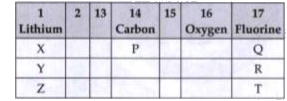Which is most reactive in base cataysed hydroysis reaction?




The correct Answer is:A
To determine which compound is the most reactive in a base-catalyzed hydrolysis reaction, we need to analyze the reactivity of the four amides based on the presence of electron-withdrawing and electron-donating groups.
1. Identify the Compounds:
We have four amides to consider:
- Compound A: Benzamide with a nitro group (NO2)
- Compound B: Benzamide with a methoxy group (OCH3)
- Compound C: Benzamide with a meta-substituted group
- Compound D: Simple benzamide without any substituents
2. Understand the Role of Electron-Withdrawing and Electron-Donating Groups:
- Electron-withdrawing groups (EWGs) increase the reactivity of the amide by stabilizing the negative charge that develops during the hydrolysis reaction.
- Electron-donating groups (EDGs) decrease the reactivity of the amide by destabilizing the negative charge.
3. Analyze Each Compound:
- Compound A (NO2): The nitro group is a strong electron-withdrawing group (both -I and -R effects). This will significantly enhance the reactivity of the amide.
- Compound B (OCH3): The methoxy group is an electron-donating group (+R effect) and has a weak -I effect. This will decrease the reactivity of the amide.
- Compound C: The meta-substituted group is less effective than the para or ortho positions for resonance but may have some -I effect depending on the specific group.
- Compound D: This compound has no substituents, making it less reactive compared to compound A.
4. Determine the Order of Reactivity:
Based on the analysis, the order of reactivity in base-catalyzed hydrolysis is influenced by the strength of the electron-withdrawing groups:
- Most Reactive: Compound A (with NO2)
- Less Reactive: Compound C (depending on the specific group)
- Even Less Reactive: Compound D (no substituents)
- Least Reactive: Compound B (with OCH3)
5. Conclusion:
Therefore, the most reactive compound in base-catalyzed hydrolysis is Compound A (the one with the nitro group).
We have four amides to consider:
- Compound A: Benzamide with a nitro group (NO2)
- Compound B: Benzamide with a methoxy group (OCH3)
- Compound C: Benzamide with a meta-substituted group
- Compound D: Simple benzamide without any substituents
- Electron-withdrawing groups (EWGs) increase the reactivity of the amide by stabilizing the negative charge that develops during the hydrolysis reaction.
- Electron-donating groups (EDGs) decrease the reactivity of the amide by destabilizing the negative charge.
- Compound A (NO2): The nitro group is a strong electron-withdrawing group (both -I and -R effects). This will significantly enhance the reactivity of the amide.
- Compound B (OCH3): The methoxy group is an electron-donating group (+R effect) and has a weak -I effect. This will decrease the reactivity of the amide.
- Compound C: The meta-substituted group is less effective than the para or ortho positions for resonance but may have some -I effect depending on the specific group.
- Compound D: This compound has no substituents, making it less reactive compared to compound A.
Based on the analysis, the order of reactivity in base-catalyzed hydrolysis is influenced by the strength of the electron-withdrawing groups:
- Most Reactive: Compound A (with NO2)
- Less Reactive: Compound C (depending on the specific group)
- Even Less Reactive: Compound D (no substituents)
- Least Reactive: Compound B (with OCH3)
Therefore, the most reactive compound in base-catalyzed hydrolysis is Compound A (the one with the nitro group).
Topper's Solved these Questions
- ALDEHYDES, KETONES AND CARBOXYLIC ACIDBook:A2ZChapter:ALDEHYDES, KETONES AND CARBOXYLIC ACIDExercise:Section A (Topicwise question
Explore 3 Videos
- ALDEHYDES, KETONES AND CARBOXYLIC ACIDBook:A2ZChapter:ALDEHYDES, KETONES AND CARBOXYLIC ACIDExercise:Section B - Assertion Reasoning
Explore 33 Videos
- ALDEHYDES, KETONES AND CARBOXYLIC ACIDBook:A2ZChapter:ALDEHYDES, KETONES AND CARBOXYLIC ACIDExercise:Carboxylic Acid
Explore 59 Videos
- ALCOHOLS, PHENOLS AND ETHERSBook:A2ZChapter:ALCOHOLS, PHENOLS AND ETHERSExercise:Section D - Chapter End Test
Explore 30 Videos
- BIOMOLECULESBook:A2ZChapter:BIOMOLECULESExercise:Section D - Chapter End Test
Explore 30 Videos
Similar Questions
Knowledge Check
Which is most reactive metal
AFeBPtCNiDCoWhich metal is the most reactive?
ASilverBLeadCIronDCaesiumWhich is most reactive of the following ?
AEthyl acetateBAcetic anhydrideCAcetamideDAcetyl chloride
Which is most reactive towards nucleophilic addition reactions?
View SolutionWhich of the following alkyl halides is most reactive in the Williamson reaction ?
View SolutionWhich of the following is most reactive towards elimination reaction?
View SolutionWhich of the following is most reactive towards elimination reaction?
View SolutionWhich of the following alkenes is most reactive towards electrophilic additon reaction?
View Solution


